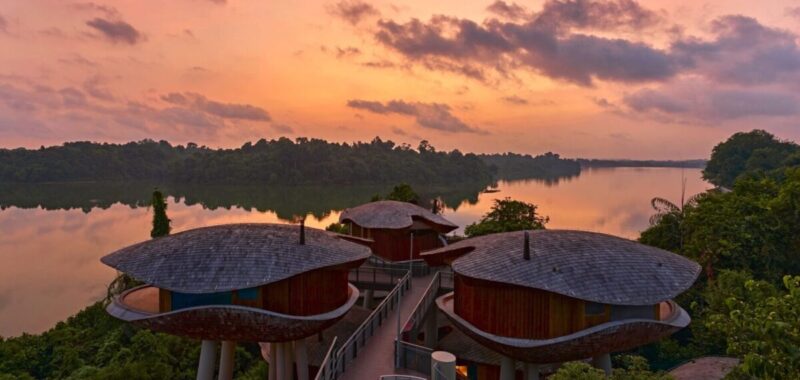
Luxury hospitality company Banyan Group plans to unveil 15 new hotels and resorts alongside five branded residences in 2025.
These plans, which include debuts in Tanzania and the Dominican Republic, signal a move beyond its traditional stronghold in Asia.
“We opened a record 18 new hotels and resorts in 2024. We are expecting to open 15 new hotels and resorts in 2025, well on track to our 100th property this year, which will be a symbolic homecoming in Singapore,” Eddy See, President and CEO of Banyan Group, told Skift.
Last year, Banyan Tree Group also embraced a sleeker image, rebranding itself as the Banyan Group. The rebranding was to help the group distinguish the original Banyan Tree luxury brand from recent additions to the portfolio, which had doubled since 2019.
The group’s 18 openings in 2024 include six in Japan and South Korea and eight in China, reflecting its multi-brand expansion strategy across Asia.
New Openings in 2025
The group’s inaugural resort Mandai Rainforest Resort by Banyan Tree in Singapore is slated to open in April this year. The 338-room resort will be within Singapore’s integrated wildlife and nature destination: Mandai Wildlife Reserve.
Other highlights include Ubuyu, Banyan Tree’s first safari resort in Tanzania’s Ruaha National Park, opening mid-year, and the group’s Dominican Republic debut with Cassia Punta Cana later this year.
“Our Tanzania launch offers a purposeful discovery experience, connecting guests to Ruaha’s untouched landscapes. Meanwhile, our entry into the Dominican Republic with Cassia Punta Cana allows us to cater to a new customer segment in the Americas,” said See.
Pivoting Beyond Asia
While Asia remains at the heart of Banyan Group’s operations, its expansion into regions like the Middle East, North America, Africa, and the Caribbean marks a deliberate pivot toward a more diversified market mix.
“Through the pandemic, we found value in seeking a more diversified market mix. This approach has been key in reducing reliance on a few countries and taking advantage of holiday patterns to smooth out fluctuations in room demand,” See explained.
The Middle East remains a growth engine, driven by rising demand for wellbeing-focused and immersive experiences.
“There is also opportunity to capture domestic market interest from high-potential source markets (e.g. the Middle East, China), to establish Banyan Group and our global brands among travellers from these regions,” See said. The group’s multi-brand approach, encompassing 12 global brands, is pivotal to this strategy, he said.
The group continues to see growth opportunities in the Middle East, and increasingly in North America, with rising demand and evolving preferences in luxury travel
Catering to A New Set of Travelers
The younger, affluent traveler is reshaping luxury hospitality. This demographic prioritizes authenticity, eco-consciousness, and experiential stays over traditional markers of luxury.
A Skift Research report estimates Gen Z’s global spending power at $143 billion, representing 40% of all consumers. Though price-conscious, they prioritize spending on travel experiences.
“The evolving demographics and opportunities in our target growth regions drive our vision for expansion and innovation,” said See. “We aim to meet existing demands while embracing emerging preferences for distinctive travel experiences.”
Through its 12 brands, Banyan Group helps tailor offerings to local cultures and traveler expectations. By combining luxury with cultural experiences, the group looks to appeal to a broad audience.
China, the fastest growing market for the group, and Japan continue to see a resurgence in luxury tourism, particularly among younger, affluent travelers, See said.
In China, the group focuses on building a multibranded presence with properties such as Banyan Tree and Garrya Yangcheng Lake in Suzhou, as well as Banyan Tree and Angsana Tengchong in Yunnan. “This helps us cater to a diverse range of travellers seeking varied experiences within a single destination,” the CEO said.
Balancing Scale and Standards
Rapid growth often challenges operational standards and See believes that balancing scale with sustainability, is essential. However, he was quick to note that brands need to be agile and genuinely responsive. “For established hospitality companies, adapting quickly while maintaining authenticity can be a complex task.”
According to See, an asset-light strategy and significant investments in technology are key enablers of scalable, high-quality operations.
“Technology supports our associates, allowing them to deliver meaningful, human-centered experiences,” See said. He emphasized that while AI and automation are integral to operational efficiency, the human touch remains irreplaceable in luxury hospitality.
Loyalty programs like withBanyan allow the group to better understand and meet guest priorities.
Branded Residences: A Growing Focus
Branded residences are becoming a key growth driver for Banyan Group. In 2025, the company will launch five new developments, including projects in Phuket, Dubai, and Madrid. These properties cater to the rising demand for luxury living spaces integrated with hospitality services.
“Expanding branded residences through partnerships enables us to plant flags in more destinations, broaden our customer base, and unlock additional revenue streams,” See noted. “This strategy also builds brand equity in untapped market segments.”
The group’s ability to adapt its offerings to diverse markets ensures a strong foothold in the burgeoning branded residences sector, according to See.
Accommodations Sector Stock Index Performance Year-to-Date
What am I looking at? The performance of hotels and short-term rental sector stocks within the ST200. The index includes companies publicly traded across global markets, including international and regional hotel brands, hotel REITs, hotel management companies, alternative accommodations, and timeshares.
The Skift Travel 200 (ST200) combines the financial performance of nearly 200 travel companies worth more than a trillion dollars into a single number. See more hotels and short-term rental financial sector performance.
Read the full methodology behind the Skift Travel 200.

